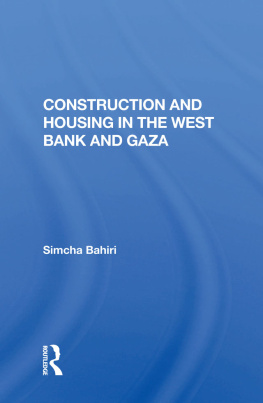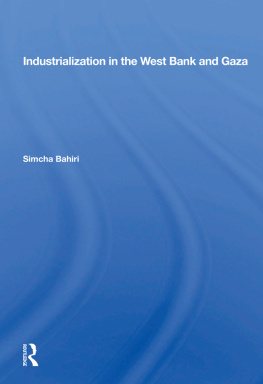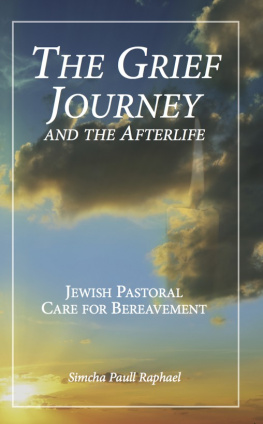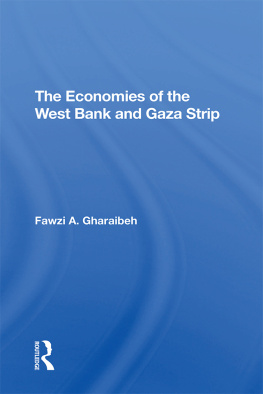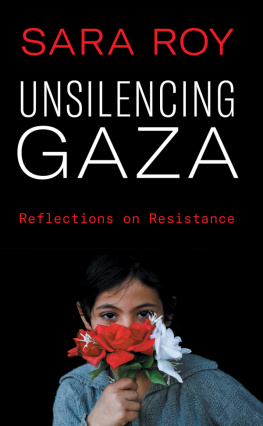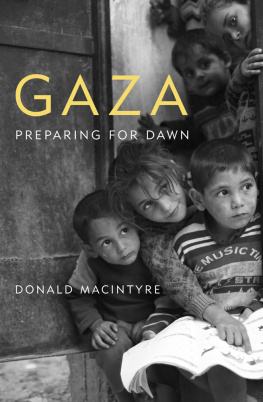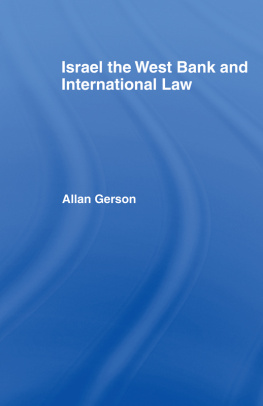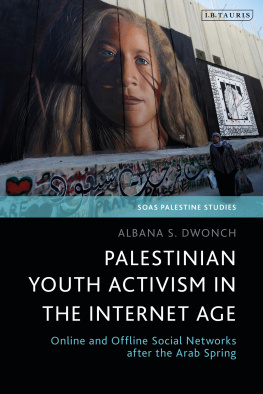Simcha Bahiri - Construction and Housing in the West Bank and Gaza
Here you can read online Simcha Bahiri - Construction and Housing in the West Bank and Gaza full text of the book (entire story) in english for free. Download pdf and epub, get meaning, cover and reviews about this ebook. year: 2019, publisher: Routledge, genre: Non-fiction. Description of the work, (preface) as well as reviews are available. Best literature library LitArk.com created for fans of good reading and offers a wide selection of genres:
Romance novel
Science fiction
Adventure
Detective
Science
History
Home and family
Prose
Art
Politics
Computer
Non-fiction
Religion
Business
Children
Humor
Choose a favorite category and find really read worthwhile books. Enjoy immersion in the world of imagination, feel the emotions of the characters or learn something new for yourself, make an fascinating discovery.
- Book:Construction and Housing in the West Bank and Gaza
- Author:
- Publisher:Routledge
- Genre:
- Year:2019
- Rating:4 / 5
- Favourites:Add to favourites
- Your mark:
- 80
- 1
- 2
- 3
- 4
- 5
Construction and Housing in the West Bank and Gaza: summary, description and annotation
We offer to read an annotation, description, summary or preface (depends on what the author of the book "Construction and Housing in the West Bank and Gaza" wrote himself). If you haven't found the necessary information about the book — write in the comments, we will try to find it.
Construction and Housing in the West Bank and Gaza — read online for free the complete book (whole text) full work
Below is the text of the book, divided by pages. System saving the place of the last page read, allows you to conveniently read the book "Construction and Housing in the West Bank and Gaza" online for free, without having to search again every time where you left off. Put a bookmark, and you can go to the page where you finished reading at any time.
Font size:
Interval:
Bookmark:

52 Vanderbilt Avenue, New York, NY 10017
2 Park Square, Milton Park, Abingdon, Oxon OX14 4RN
Product or corporate names may be trademarks or registered trademarks, and are used only for identification and explanation without intent to infringe.
Bahiri, Simcha.
Construction and housing in the West Bank and Gaza / by Simcha Bahiri.
p. cm.
"West Bank Data Base Project"Verso of t.p.
ISBN 0-8133-7982-2
1. HousingWest Bank. 2. HousingGaza Strip. 3. Construction industryWest Bank. 4. Construction industryGaza Strip.
I. West Bank Data Base Project. II. Title.
HD7358.45.W47B34 1990
338.4'76908'095695dc20
CIP
- iv
- To outline the state of the construction sector of the economy and its part in development in the WB/GS based on statistics from various sources;
- To describe both barriers and catalysts to development of housing and construction;
- To assess the dependence of the construction sector of the Territories on Israel;
- To determine present housing conditions and future needs;
- To project potential economic development scenarios and their consequences for construction under various possible political-economic options; and
- To provide Israeli and Palestinian planners and/or decision-makers with information to assess consequences of various alternatives.
- a continuation of the pre-uprising (or pre-intifada) situation and occupation, and hitherto existing trends in the territories - e.g. no major change of policy by Israel (or Jordan) and no major local major demographic or building shift (i.e. a conservative scenario);
- a continuation of the occupation, albeit with a granting of some degree of autonomy and/or a renewed Jordanian participation, and an easing of restrictive economic barriers and constraints with a consequent improvement in the "quality of life" (i.e. a reformist scenario);
- a separation of the West Bank and Gaza Strip from Israel, either in the framework of a Palestinian-Jordanian confederation or as an independent Palestinian entity (i.e. a radical scenario).
Font size:
Interval:
Bookmark:
Similar books «Construction and Housing in the West Bank and Gaza»
Look at similar books to Construction and Housing in the West Bank and Gaza. We have selected literature similar in name and meaning in the hope of providing readers with more options to find new, interesting, not yet read works.
Discussion, reviews of the book Construction and Housing in the West Bank and Gaza and just readers' own opinions. Leave your comments, write what you think about the work, its meaning or the main characters. Specify what exactly you liked and what you didn't like, and why you think so.

